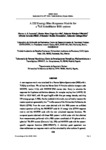
Please use this identifier to cite or link to this item:
http://ricaxcan.uaz.edu.mx/jspui/handle/20.500.11845/762Full metadata record
| DC Field | Value | Language |
|---|---|---|
| dc.contributor | 6207 | es_ES |
| dc.contributor.other | https://orcid.org/0000-0002-7081-9084 | es_ES |
| dc.coverage.spatial | Global | es_ES |
| dc.creator | de Sousa Lacerda, Marco Aurelio | - |
| dc.creator | Vega Carrillo, Héctor René | - |
| dc.creator | Mendez Villafañe, Roberto | - |
| dc.creator | Lorente, Alfredo | - |
| dc.creator | Ibañez Fernández, Sviatoslav | - |
| dc.creator | Gallego Díaz, Eduardo | - |
| dc.date.accessioned | 2019-03-14T18:19:17Z | - |
| dc.date.available | 2019-03-14T18:19:17Z | - |
| dc.date.issued | 2016-09-28 | - |
| dc.identifier | info:eu-repo/semantics/publishedVersion | es_ES |
| dc.identifier.uri | http://localhost/xmlui/handle/20.500.11845/762 | - |
| dc.identifier.uri | https://doi.org/10.48779/6yty-ct49 | es_ES |
| dc.description.abstract | A new response matrix was calculated for a Bonner Sphere Spectrometer (BSS) with a 6LiI(Eu) scintillator. We utilized the Monte Carlo N-Particle radiation transport code MCNPX, version 2.7.0, with ENDF/B-VII.0 nuclear data library to calculate the responses for 6 spheres and the bare detector, for energies varying from 9.441E(-10) MeV to 105.9 MeV, with 20 equal-log(E)-width bins per energy decade, totalizing 222 energy groups. A BSS, like the modeled in this work, was utilized to measure the neutron spectrum generated by the 241AmBe source of the Universidad Politécnica de Madrid (UPM). From the count rates obtained with this BSS system we unfolded neutron spectrum utilizing the BUNKIUT code for 31 energy bins (UTA4 response matrix) and the MAXED code with the new calculated response functions. We compared spectra obtained with these BSS system / unfold codes with that obtained from measurements performed with a BSS system constituted of 12 spheres with a spherical 3He SP9 counter (Centronic Ltd., UK) and MAXED code with the system-specific response functions (BSS-CIEMAT). A relatively good agreement was observed between our response matrix and that calculatedby other authors. In general, we observed an improvement in the agreement as the energy increases. However, higher discrepancies were observed for energies close to 1E(-8) MeV and, mainly, for energies above 20 MeV. These discrepancies were mainly attributed to the differences in cross-section libraries employed. The ambient dose equivalent (H*(10)) calculated with the 6LiI-MAXED showed a good agreement with values measured with the neutron area monitor Berthold LB 6411 and within 12% the value obtained with another BSS system (BSS-CIEMAT). The response matrix calculated in this work can be utilized together with the MAXED code to generate neutron spectra with a good energy resolution up to 20 MeV. Some additional tests are being done to validate this response matrix and improve the results for energies higher than 20 MeV. | es_ES |
| dc.language.iso | eng | es_ES |
| dc.publisher | Sociedad Mexicana de Irradiación y Dosimetría | es_ES |
| dc.relation | https://www.google.com/search?client=firefox-b-d&q=ISSSD+2016 | es_ES |
| dc.relation.uri | generalPublic | es_ES |
| dc.rights | Atribución-NoComercial-CompartirIgual 3.0 Estados Unidos de América | * |
| dc.rights.uri | http://creativecommons.org/licenses/by-nc-sa/3.0/us/ | * |
| dc.source | INTERNATIONAL SYMPOSIUM ON SOLID STATE DOSIMETRY (16° .-Tuxtla Gutiérrez, Chiapas .- 24 al 28 de Septiembre), México, pp. 128-150 | es_ES |
| dc.subject.classification | CIENCIAS FISICO MATEMATICAS Y CIENCIAS DE LA TIERRA [1] | es_ES |
| dc.subject.other | Monte Carlo | es_ES |
| dc.subject.other | Neutron Spectrometry | es_ES |
| dc.subject.other | Bonner sphere neutron spectrometer | es_ES |
| dc.title | A 222 Energy Bins Response Matrix fora 6LiI Scintillator BSS system | es_ES |
| dc.type | info:eu-repo/semantics/conferenceObject | es_ES |
| Appears in Collections: | *Documentos Académicos*-- UA Ciencias Nucleares | |
This item is licensed under a Creative Commons License

